page 63
Note: the contents of this page as well as those which precede and follow, must be read as a continuation and/or overlap in order that the continuity about a relationship to/with the dichotomous arrangement of the idea that one could possibly talk seriously about peace from a different perspective as well as the typical dichotomous assignment of Artificial Intelligence (such as the usage of zeros and ones used in computer programming) ... will not be lost (such as war being frequently used to describe an absence of peace and vice-versa). However, if your mind is prone to being distracted by timed or untimed commercialization (such as that seen in various types of American-based television, radio, news media and magazine publishing... not to mention the average classroom which carries over into the everyday workplace), you may be unable to sustain prolonged exposures to divergent ideas about a singular topic without becoming confused, unless the information is provided in a very simplistic manner.
Let's face it, humanity has a lousy definition, accompanying practice, and analysis of peace.
On page 61 in this Peace series the topic of headhunting compared to the activities of the Nobel Prize committee was mentioned. The Nobel Prize is thus one of several different types of headhunting trophies it claims and performs a respective "headhunting" ceremony. In fact, its activities in seeking out the best trophies to be displayed by ceremony is a confession that it recognizes different types of "heads" due to particular intellectual activities. But the Nobel Prize committee is not alone in its headhunting forays. We find different types of scouting parties in academics, various businesses, institutions and so many other activities as well. The phrase "they have a good head on their shoulders" or that someone is a "good egg" (egg head), or someone has a brilliant, creative, industrious, inventive, original mind... etc., are variations of the same primitive headhunting practice having been identified by anthropologists. Indeed, variations of Headhunting occur so often, there are numerous references coincident with different times and places which display some reverence or at least cultural importance of directing attention to the head. Acts such as:
- Cutting off one's head with a Guillotine
- Shooting zombies in the head
- Severing the head with a sword for some crimes
- An idea as a "brain child"
- Insanity or other mental problem
- Trephination
- Hair cutting, adorning, grooming rituals
- etc...
No less, even the biology of many species exhibits a particular developmental orientation to the head by having so many of their sense organs associated nearby such as the eyes, ears, nose and mouth. The human orientation towards the head appears to be part of a biological design encouraged by the present Earthly environmental conditions... which are deteriorating.
Like Peace, beauty, love, and numerous other word-labels— we identify a host of different perceptions that not everyone might agree originate in the mind or brain. But should they be for the sake of analysis, these too would then be seen as characterizing different types of headhunting activities related to a primitive past of humanity and as a basic organizational methodology employed by biology as a sort of basic frame-work. It is a framework used by biology and a "gamework" used in various ways not only amongst individuals of a given age, but of different ages. For example, though the idea that the War/Peace is a standard dichotomy prevalent in all ages might well indicate a basic mental pattern consistent with all humans irrespective of time and place in history and portrayed in various guises; one might well argue that this suggests a faulty mentality or overall biological schematic because of the rise in using triple patterns— suggesting a need for a third element in this ages-old double formula of war and peace. However, the presence of triple patterns being used in the distant past does not automatically tell us that a triple way of thinking was applied the same or by all people. In such a perspective, though we of today claim that people in the past did in fact organize triple patterns such as in the case of deities to be worshipped or respectfully acknowledged, this doesn't mean our present day interpretation is that which was used as the logic of a past era. In other words, while they may have used a pattern-of-three, there remained an over-riding emphasis on the presence of a dominant pattern-of-two such as in the array: "Major Premise-Minor Premise... Conclusion". The word "Conclusion" is set apart and is not provided with its own "premise" label such that it would be denoted as "Conclusion Premise".
The War/Peace dichotomy may have a third element in the mind of some people, but for the most part, these two remain the dominant mental orientation with an especial reference like a mental hangup or obsession. It is illustrated in the old names for numbers labeling system where (in culturally respective languages) the word "One" represented the numerical value of 1; the word "two" represented the numerical value of 2; and any value beyond the 2 was considered "Many". Hence, while the word-labels "one" and "two" directly reference numerical values, the word-label "many" was not specific to a singular numerical value. In other words, the first two words had specific signification, the third one did not. This means the architecture of the brain and coding of the mind was in a primitive state as is the case when it comes to the peace/war dichotomy. Thus, we must ask ourselves how do we get humanity to progress beyond this stage... or is humanity capable of doing so? Does humanity repeat the same patterns because it is being forced to comply by a deteriorating environment that expects humanity to adapt to its changes in order to maintain some semblance of equilibrium along a course of an associated evolution with an environment headed towards a demise... whose scale of events must be measured in terms of a given biology and not a given geology?
Differentiating between mental patterns using a type of enumerated identification system such as the peace/war dichotomy and a syllogistic logic formula as a trichotomy (for example, the Hegelian Thesis/Anti-thesis— Synthesis); we can thus more easily view the frequency at which such patterns occur, so long as we do not over-complicate the basic comparative model by seeking out particular characteristics associated with the patterns in order to give ourselves and/or others that what we are doing is anything but a simple analogy because the language employed in discussing our efforts is meant to convey some sort of intellectual sophistication. In other words, in looking at basic patterns, some researchers may engage in their own value of a dichotomy or trichotomy in order to give the impression that what they are involved with is anything but a simple comparison.
Let's take the example of the Virgin- Mother- Crone triad as but one of many different patterns-of-three that need not be limited to an analysis which references presumed religious beliefs. While it can be used as a suggested representative illustration that women also created triple- patterned ideas to go along with the many triple gods used by men, whether or not the ideas were contemporary with one another; the language- displayed hierarchical arrangement from young to old (in the Virgin, Mother, Crone) sequence, may not be the actual formula of logic used when the idea prospered in the past. In other words, the sequence may well have been reversed in one or more occasions, or even alternatively arranged for individualized contexts. While the from young to old sequence may suit the mental landscape of present day aficionados (affectionate fans), it is of value to consider that there may a better way of delving into this triadic formula by not only altering the sequence, but by correlating it to one or another triad such as an attempt to define the War-Peace dichotomy in a triple format, where the third item is not readily known or understood, and presents us with a numinous character that we might playfully associate with the word ghost or apparition.
The from young to old sequence not only suggests a type of mental leaning towards thinking in terms of a hierarchy, but we might also note the presence of a numerical arrangement leading from a small number to a larger one. In addition, in terms of a relationship to War and Peace, the Virgin might well represent trauma with respect to birthing a child and hence, blood, pain and one might include violence if so predisposed along this line of thinking. In terms of a motherly role, we might well claim peaceful interests, despite arguments arising from those who have experienced bad mothering/nurturing techniques. No less, the role of the crone may well signify some especial wisdom to be acquired (after the episodes of war and peace), yet in using the human form we are inclined to take the metaphor into the biological realm of death instead of a philosophical landscape extending into a functional immortality.
A rather humorous perspective arises when looking at the Virgin- Mother- Crone triad in that the Virginity of the Virgin is often assigned a special functionality in that a non-sexually active woman supposedly having given birth to individuals associated with religion or religious philosophy such as Christianity (Jesus), Buddhism (Buddha), and others. The problem with this is that we must not be so quick to interpret the idea of "virgin birth" with what we of today may interpret it to mean. When there exists evidence which denotes the prevailency of frequent rape and the presence of an illusionary form of "common sense" amidst a social environment of superstition, the notion of a "virgin birth" is like the old excuse in which pregnancy was described as being due to "something in the water". It not only serves as a cover-up, but as an excuse for those who want to provide an acceptable answer to an otherwise indelicate or indiscrete circumstance. This is a viable consideration considering the fact that many a woman gets pregnant and don't realize that her symptoms of supposed illness are reactions due to a pregnancy she is not even aware of. And given the state of poor nutrition and herbal knowledge to assist in drugging people, date rape drugs were used in the past by uncles, cousins, fathers, neighbors, etc..., on unsuspecting women. Hence, a pregnancy that arises from having no recollection of having sex either due to a drug or poor consciousness levels from a lack of nutrition coupled with slave-like working conditions; necessarily needs a "good" reason and not a "bad" interpretation. Claiming a virgin birth not only provides some presumed special attribute to the child, but the mother and mother's family and extended family... to at least three generations. (The daughter/Virgin, Mother, and Grandmother/Crone.)
Granted that the comparison between the Virgin-Mother-Crone triad and the truncated model of War- Peace- (?) is an imaginatively rendered correlation, both of them nonetheless... when stripped of the enculturated trappings, reveal patterns of human cognition... of human thinking patterns occurring in the presence of an incrementally deteriorating environment. Trying to solve the peace/war problem appears like trying to plug holes caused by a rotting deck on a ship called Earth.
In attempting to analyze the idea of peace so very frequently associated with war... and thus describing an assumed dichotomy; it is of value to set it up in contrast to other mental patterns such as triples, though one might want to include other patterns identified with a numerical reference or quantity. Yet, it is of value to stress that what we are looking at is the overall pattern irrespective of its applied context in religion, science or whatever subject a person may be particularly interested in... though such a venture is itself a particularly subjective venue of consideration. In other words, we are not looking to confirm or deny a given religious or non-religious scientific belief or view. With this stated, it is of need to emphasize that a collection of ideas involving religious themes or even culled from a source whose author has a religious oriented interest, can be interpreted as a comparative foray into basic cognitive patterns. Hence, the reader must not lose sight of the objective in providing different models of the same pattern in order to assist in recognizing recurring cognitive themes that often need to be removed from their applied context... as a sort of disrobing or removing personality characteristics in order to see the basic mechanisms of functionality.
For example, in the following illustration of various "patterns-of-three", the author does not give an indication that they are looking at the information in terms of illustrating a basic mental pattern compared to other basic mental patterns stripped of their cultural applications, though they may nonetheless understand this idea. The context is not one in which overall basic human cognition is being analyzed, but certain "personalities" of different triple patterns are. Likewise, the dichotomous personality of "peace/war" seen as a pattern-of-two that illustrates a basic mental pattern using a numerical indexing formula as a type of analytical tool, which can be used to examine other mental patterns in different cultures and time periods to be associated with overall human brain development from the distant past. In so many cases the same basic patterns are used again and again that some may want to define as being "natural and normal" while others may interpret to mean that humanity is not actually growing... and may in fact be enslaved to repeat such patterns because they are conducive to maintaining a relative state of equilibrium in an incrementally deteriorating environment. It's not that humanity can't think otherwise, but that it is being limited by an environment which suppresses the advent of a growth which might well cause humanity to exceed the environment's grasp of enslavement. The "grasp" in such a regard has multiple forms such as electro-magnetism, oxygen, heat, gravity, etc., which without such leashes humanity would become quite a different creature... perhaps not needing any present day art, religion or science... including mathematics.
A brain that undergoes a developmental maturation may well view a triple perspective in an over-valued formula defined in religious or scientific terms. The advent of acknowledging the presence of a triple pattern in place of or in contrast to a dual pattern can be like a Euphoric Eureka! moment that is associated with some sort of denoted great power, wisdom, insight or knowledge that has been bestowed upon someone. The recognition of one or more triple patterns as being used as a suggested superiority can either be accepted or denied in context; or removed from the applied context as a reference to human brain development undergoing particular environmental/sociological circumstances. Whereas we may find instances where the usage of a particular pattern is either felt to be true or false, the fact that it is a pattern that is being used, whether we agree or disagree, does not alter the presence of its usage. While its usage may be based on one or more lies or misinterpretations, its usage nonetheless conveys that the human brain has grasped on to it... right or wrong... perhaps because the human brain has been trained to adopt a usage of the pattern to fulfill some adaptive function... though the adaptation has only a short-term value/relevance.
Let us take the Christian Doctrine of the Trinity for example. Just because it doesn't appear in the Bible and that it may have had some influence from pagan religions, does not mean the underlying "three" pattern is a lie... in terms of developmental human cognition. Despite the application and cultural servicing, it is a basic mental pattern which can be identified in numerous subjects. The same goes for the peace/war dichotomy, both as an oppositional and a complementary usage of duality. The following author's interest in a "Threesological" theme (irrespective of the religious context) bespeaks of a type of cognition that is not being discussed just as is the dual pattern of peace/war in most culturally applied contexts. In other words, it is a type of "functional fixedness" with respect to a given cognitive pattern. The "three", "two", etc., cognitive patterns are not applied in a very narrow sense, and not as an expression of a type of biological mentality under deteriorating environmental conditions. Alternatively described, the "Trinity", in all its various guises both in and out of this or that religion in the present or the past, as well as this or that science, sport, art or whatever is the subject of a particular person's endeavor, is but an expression of a particular type of brain functionality that one might even argue is part of a larger complex of brain development in this respective (incrementally deteriorating) environment.
Without identifying the Trinity in religion as a mental pattern-of-three that exists in other subjects, one can easily overlook that a religious Trinity (just like a peace/war dichotomy) is a pattern of mental behavior related to biology cast in a particular environment, and subject to the changes in the environment as a means of gaining or maintaining some relative equilibrium as it continues to deteriorate. Beliefs thus become expressions of "adjustable rationalizations" for the sake of attempting to survive as best one can under incrementally deteriorating conditions coupled to the disintegrations of one's biology. However, despite all arguments which attempt to refute a numerically identified pattern labeled a trinity, duality or whatever; there is a limitation to the types of numerical patterns being used. The deteriorating environment is forcing humanity to use a very small assortment of numerically identifiable patterns. For example, we can acknowledge usage of singularities, dualities, triplicities, quadratics, quintets, sextuplets, septuplets, etc., but we do not see ideas which involve all available numbers. There is a limitation to how many and what kind of ideas are being used repetitiously from one culture and historical venue to another. It's not that humans are incapable of thinking in many other patterns, but survival requirements on a deteriorating Earth forces humanity into a very narrow range of compliance. Everybody is rationalizing the value of a particular pattern in a particular way because it is part of their individualized adaptation to an ongoing planetary deterioration.
Whether a person points out numerous examples of patterns-of-two or patterns-of-three, the fact that biology provides us with multiple examples of development described as growth, can lead us to suspect that the usage of ideas with a "three" pattern may be an indication of a developmental growth beyond a two-pattern, whether or not the patterns exhibit truth or lies. The fact remains that such patterns are nonetheless being used and not other patterns. No one or no-thing forces humanity to use a limited source of patterns except for the planet. It is rather amazing that out of trillions of available patterns identifiable with enumeration, that only a very few are being used by humans in different cultures and different time periods. Humanity is limited, is forced into a cognitive conservation effort, because the environment enslaves humanity to do its bidding. The dichotomy of peace/war is part of the forced conservation of rationalized adjustments. Fortunately more people are viewing the idea of a religious-based trinity idea as but one of many different forms of patterns-of-three related to human brain functionality adopting this particular formulation as but one of many survival mechanisms. The underlying "truth" is not in the religious dogma being espoused, but in its application as a generality of thought applied to socially rationalized specifics... like the trinity in genetics known as a triplet coding system or the trinity in particle physics known as electron-neutron-proton, or the many geometric Trinitarian forms known as triangular pyramids, triangular arrowheads, etc..., all of which are different illustrations of a cognitive orientation towards the "three" just as the peace/war ensemble is a depiction of a cognitive orientation towards the "two"... whatever these abstractions actually mean when stripped of human labels and applications.
by Rav Sha'ul
The Encyclopedia Britannica, Micropedia Volume 11, page 928, gives us the following facts about the trinity.
TRINITY, in Christian doctrine, the unity of Father, Son, and Holy Spirit as three persons in one Godhead. Neither the word Trinity nor the explicit doctrine appears in the New Testament, nor did Jesus and his followers intend to contradict the Shema in the Old Testament: "Hear, O Israel: The Lord our God is one Lord" (Deuteronomy 6:4). The doctrine developed gradually over several centuries and through many controversies.
Let's take a look at the LONG history of Trinitarian pagan gods and pagan worship. It seems like everyone has a Trinity, except "The True Followers of Messiah Yahusha." In fact, as we see below early "Christianity" was formulated in a pool of pagan beliefs nurtured not in the Hebrew Torah but rather in the schools of Alexandria a meeting place of Eastern and Western pagan religious thoughts and philosophies. The Trinity being the most striking example of a doctrine nowhere to be found in the Torah or the New Testament yet was assimilated into Christianity directly from pagan origins:
The Religions of Ancient Greece and Babylonia, by A. H. Sayce. pages 229-230, clearly tells us that the Greek philosophical ideas were developed in Alexandria, Egypt from the pagan mystery religions.
Many of the theories of Egyptian religion, modified and transformed no doubt, have penetrated into the theology of Christian Europe, and form, as it were, part of the woof in the web of modern religious thought. Christian theology was largely organized and nurtured in the schools of Alexandria, and Alexandria was not only the meeting place of East and West, it was also the place where the decrepit theology of Egypt was revivified by contact with the speculative philosophy of Greece. Perhaps, however, the indebtedness of Christian theological theory to ancient Egyptian dogma is nowhere more striking than in the doctrine of the Trinity. The very terms used of it by Christian theologians meet us again in the inscriptions and papyri of Egypt. Originally the trinity was a triad like those we find in Babylonian mythology. The triad consisted of a divine father, wife, and son. The father became the son and the son the father through all time, and of both alike the mother was but another form.
The simple Truth found in the Bible is that YHVH is the God of Yahusha the EXACT same way he is our God. YHVH is the Father of Yahusha the EXACT same way He is our Father. Yahusha is the first born son of the resurrection of many more begotten sons to come. This is by the very words of the resurrected Messiah, who called us his BROTHERS (brethren) and clearly told us his relationship to YHVH was the same as ours even AFTER he was resurrected and fully begotten into the family of Elohim (God).
John 20:17
17 Yahusha said to her, "Do not cling to Me, for I have not yet ascended to My Father; but go to My brethren (he is our brother not our God) and say to them, 'I am ascending to My Father and your Father, and to My God and your God.' "
The Triple Deities of Pagan Religions
Triple deity
A triple deity (sometimes referred to as threefold, tripled, triplicate, tripartite, triune or triadic) is a deity associated with the number three. Such deities are common throughout world mythology; the number three has a long history of mythical associations. C. G. Jung considered the arrangement of deities into triplets an archetype in the history of religion.
The deities and legendary creatures of this nature typically fit into one of the following general categories:
- triadic ("forming a group of three"): a triad, three entities inter-related in some way (life, death, rebirth, for example, or triplet children of a deity) and always or usually associated with one another or appearing together;
- triune ("three-in-one, one-in-three"): a being with three aspects or manifestations;
- tripartite ("of triple parts"): a being with three body parts where there would normally be one (three heads, three pairs of arms, and so on); or
- triplicate-associated ("relating to three corresponding instances"): a being in association with a trio of things of the same nature which are symbolic or through which power is wielded (three magic birds, etc.)
Pagan Rome worshipped Isis, Horus, and Seb. The round disk wafer IHS (called the Christogram) symbol of Isis, Horus, Seb, was eaten as food for the soul. This was integrated into Christianity as The wafer used in the Eucharist is round with IHS engraved on it. And this pagan Trinity of Isis, Horus, Seb was represented by IHS which was then made the Christogram for Jesus H. Christ (Hesus Horus Krishna). We see below that the entire concept of the Trinity is directly out of Babylon itself! When asked to explain the Trinity most Christian are stumped and call it a "Mystery". EXACTLY! It is the "Mystery" of the religion of Babylon, Mystery Babylon.
The Outline of History, by H. G. Wells. page 307, tells us:
The trinity consisted of the god Serapis (=Osiris+Apis), the goddess Isis (=Hathor, the cow-moon goddess), and the child-god Horus. In one way or another almost every other god was identified with one or other of these three aspects of the one god, even the sun god Mithras of the Persians. And they were each other; they were three, but they were also one.
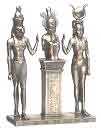
Many of the theories of Egyptian religion, modified and transformed no doubt, have penetrated into the theology of Christian Europe, and form, as it were, part of the woof in the web of modern religious thought. Christian theology was largely organized and nurtured in the schools of Alexandria, and Alexandria was not only the meeting place of East and West, it was also the place where the decrepit theology of Egypt was revivified by contact with the speculative philosophy of Greece.
Perhaps, however, the indebtedness of Christian theological theory to ancient Egyptian dogma is nowhere more striking than in the doctrine of the Trinity. The very terms used of it by Christian theologians meet us again in the inscriptions and papyri of Egypt.
Originally the trinity was a triad like those we find in Babylonian mythology. The triad consisted of a divine father, wife, and son.
The father became the son and the son the father through all time, and of both alike the mother was but another form.
Statue of Liberty,
The Christian/Babylonian Trinity
... Reference: Wikipedia: Hekate
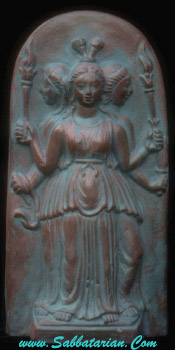
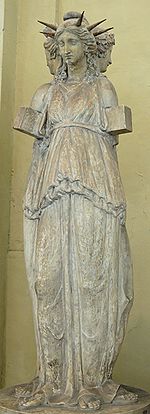
What most people fail to realize is the "Statue of Liberty" is nothing more than a mammoth idol of the Hecate goddess an idol of her shown on the left. The Laginetan goddess may have had a more infernal character than scholars have been willing to assume." In Ptolemaic Alexandria and elsewhere during the Hellenistic period, she appears as a three-faced goddess associated with magic, witchcraft, and curses. Today she is claimed as a goddess of witches and in the context of Hellenic Polytheistic Reconstructionism. Some neo-pagans refer to her as a "crone goddess", though this characterization appears to conflict with her frequent characterization as a virgin in late antiquity. She closely parallels the Roman goddess Trivia.
The "Hecate" goddess of Greek Mythology (on the left). Notice, she is a carbon copy of our "Statue of Liberty" as we will soon see below. An ancient Fertility goddess, also identified with Persephone, as Queen of Hades (underworld), and protector of witches.
The "Hecate" or "Hekate" is characterized as a Trinity, that existed within pagan mythology as a three faced goddess. The three faces represented the "Maiden", the "Matron" (or Mother), and "the "Crone". The ancient concept of "The Trinity" most certainly affected the decisions of the ancient Roman Catholic church. What better way for Satan to overwhelm the True Hebrew Messianic movement by creating a Pseudo Greek-Roman Messianic movement called Christianity (Anti-Messianism). Trinitarians deny this, but facts are facts.
The Hecate Trinity was also associated with Diana. At her sacred grove at Aricia, on the shores of Lake Nemi a triplefold Diana was venerated from the late sixth century BCE as Diana Nemorensis. "The Latin Diana was conceived as a threefold unity of the divine huntress, the Moon goddess, and the goddess of the nether world, Hekate," Albert Alföldi interpreted the late Republican numismatic image, noting that Diana montium custos nemoremque virgo ("keeper of the mountains and virgin of Nemi") is addressed by Horace as diva triformis ("three-form goddess"). Diana is commonly addressed as Trivia by Virgil and Catullus.
The modern understanding of Hecate has been strongly influenced by syncretic Hellenistic interpretations. Many of the attributes she was assigned in this period appear to have an older basis. For example, in the magical papyri of Ptolemaic Egypt, she is called the 'she-dog' or 'bitch', and her presence is signified by the barking of dogs. In late imagery she also has two ghostly dogs as servants by her side. However, her association with dogs predates the conquests of Alexander the Great and the emergence of the Hellenistic world. When Philip II laid siege to Byzantium she had already been associated with dogs for some time; the light in the sky and the barking of dogs that warned the citizens of a night time attack, saving the city, were attributed to Hecate Lampadephoros (the tale is preserved in the Suda). In gratitude the Byzantines erected a statue in her honor.
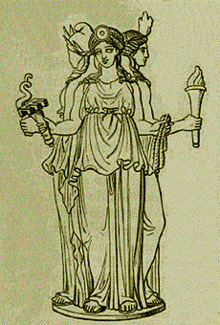
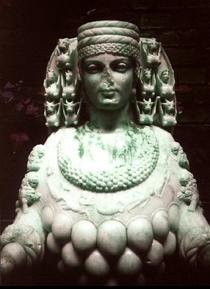
As a virgin goddess, she remained unmarried and had no regular consort. Hecate has survived in folklore as a 'hag' figure associated with witchcraft. Strmiska notes that Hecate, conflated with the figure of Diana, appears in late antiquity and in the early medieval period as part of an "emerging legend complex" associated with gatherings of women, the moon, and witchcraft that eventually became established "in the area of Northern Italy, southern Germany, and the western Balkans." This theory of the Roman origins of many European folk traditions related to Diana or Hecate was explicitly advanced at least as early as 1807. The Statue of Liberty is based on The Roman Goddess Libertas, the Roman goddess of freedom. Originally as goddess of personal freedom, she later became the goddess of the Roman commonwealth.
Greek equivalent: Ishtar (pictured on the right) is the Akkadian counterpart to the Sumerian Inanna and to the cognate northwest Semitic goddess `Ashtart. Anunit, Astarte and Atarsamain,The goddess of fertility and sexuality. To the right is a picture of the Babylonian fertility goddess Ishtar (Easter in English). Ishtar is portrayed as a trinitarian god with Baal the Sun God/Tammuz the Sun of God/Ishtar the Queen of Heaven... this is where we get the Christian Trinity as incorporated into the "Christian Church" by the sun worshipping emperor Constantine at the Council of Niceae.
Lady Liberty, the goddess of witchcraft and the Statue of "Libertas or Liberty". The Statue of Liberty is based on The Roman Goddess Libertas, the Roman goddess of freedom. Originally as goddess of personal freedom, she later became the goddess of the Roman commonwealth. Greek equivalent: Ishtar is the Akkadian counterpart to the Sumerian Inanna and to the cognate northwest Semitic goddess `Ashtart. Anunit, Astarte and Atarsamain, The goddess of fertility and sexuality. On monuments and seal-cylinders Inanna/Ishtar appears frequently with bow and arrow, though also simply clad in long robes with a crown on her head and an eight-rayed star as her symbol.
Moving right along, we find the other side of the story paints quite a different picture. In celebration of the centenary of the first Masonic Republic in 1884, the Statue of Liberty was presented to the Masons of America, as a gift from the French Grand Orient Temple Masons. The Masonic "Torch of Enlightenment" was also referred to as the "Flaming Torch of Reason", by the Illuminati Masons in the 1700's and in 1884, the cornerstone for the Statue of Liberty was placed in a solemn ceremony, by the Masonic lodges of New York, free masonwatch.freepress-freespeech.com/statue_of_liberty.html. Below is the cornerstone of the Statue of Liberty, dedicated to and by Freemasons.

References:
- circle sanctuary.org/circle/articles/pantheon/GoddessFreedom.html
- fulfilled prophecy.com
- heal the land.wordpress.com/2008/02/23/statue-of-liberty-roman-goddess-libertas-babylonian-ishtar-easter-also-semiramis-isis-juno/
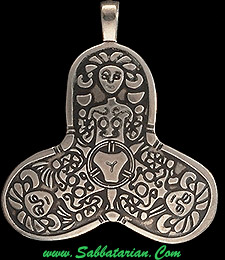

Irish Catholic St. Brigit medalion. The goddess of the flame to the ancient Celts, she has survived into our time as "St. Bridget" in the Irish catholic church. To this day her 'eternal flame' burns in Kildare, Ireland and her ancient sacred wells are still revered and visited. It is believed by pagan catholics that Brigit, Lady of the Fairies - watches over their sacred green places and, if you look into her Magickal Mirror, you can see the Faerie Realm. Here she is presented as a cloverleaf Trinity.
Brigit is a goddess who survived the onslaught of catholic Christopaganism. She wasn't turned into a devil like so many other goddesses. So great was the love of the Irish Celtic people for this deity, that they retained all her characteristics as a pagan-catholic saint! They would not have had anything to do with catholicism (pagan christianity) if they couldn't keep Brigit. So the catholic church had no choice but to make her a nun and a saint. She is a triple goddess. This triple aspect of the goddess is where catholics got the idea of exploiting the Trinity concept. The three-leaf shamrock was originally of "The Three Mothers", as well as the three phases of the moon being her symbols. She shares some attributes with the ancient Greek triple goddess Hecate.
There is a Swedish St Bridget also. Brigit's fame has been far and wide. Even as far as Africa, having come to Haiti in the hearts of deported Irish and Scottish indentured servants. However she went through a radical transformation, and her distant relative Maman Brigitte bears little resemblance, being rather a goddess of vengence. She, did, however, retain the healing aspects, being called on to cure those at death's door.
Brigit is known by various names, Brigit being the most ancient form. The name variations are: Brighid, Bride (Scottish), Brid, Brigit, Bridget, Brigantia (English), Brigan, Brigindo (Gaul) and Brigandu. Her name derives from her worship by the pre-Christian Brigantes, who honored her as identical with Juno, Queen of Heaven. Into the 18th Century, her sacred flame was tended, at first, by priestesses, who later became catholic nuns, when the pagan shrine became a convent, at Kildare, Ireland. These nineteen virgin priestesses (called nuns by the catholic church) were called 'Daughters of the Flame'. No man was ever allowed near. In fact, these women had other women in the village bring them their necessary supplies so they wouldn't have to deal with men. This no-men policy infuriated the catholic church. Because they would not submit themselves to inspection by a priest, the bishop ordered the sacred flame to be extinguished. Even so, Brigit remained Ireland's most popular saints, and in 1993, the Brigidine sisters of Ireland rekindled her flame at Kildare. Brigit's triple aspects are of Inspiration, Smithcraft, and of Healing.
- As the goddess of Inspiration, she blesses poetry, creativity, prophecy and the arts. She was even esteemed as the patron diety of language, having inspired the alphabet.
- As the goddess of Smithcraft, she blesses blacksmiths, goldsmiths, and other crafters of the household.
- As goddess of Healing, she blesses physical and spiritual healing, fertility of crop and livestock and mid-wifery.
Imbolc (Candlemas and Groundhog Day), the Celtic spring festival, honors Brigit. The Druids called this sacred holiday Oimelc, meaning "ewe's milk". Held on February 1st or 2nd, it celebrated the birthing and freshening of sheep and goats. The catholic version of Imbolc (Candlemas), also, involves much elaborate rituals and feasting, and to this very day, many Irish homes have a St Brigit's cross for protection, still made from rushes as in days of old.
reference: Wikipedia: Geryon
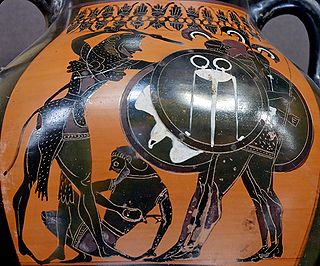
In Greek mythology, Geryon (Ancient Greek: Γηρυών; gen.: Γηρυόνος), son of Chrysaor and Callirrhoe and grandson of Medusa, was a fearsome giant who dwelt on the island Erytheia of the mythic Hesperides in the far west of the Mediterranean. A more literal-minded later generation of Greeks associated the region with Tartessos in southern Iberia.[1]
Geryon was often described as a monster with human faces. According to Hesiod[2] Geryon had one body and three heads, whereas the tradition followed by Aeschylus gave him three bodies. As seen in the picture on the left, Geryon was a "Trinity" having 3 bodies, 3 heads, and 3 shields.
reference: Wikipedia: Cerberus
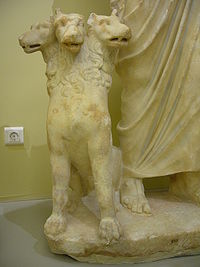 Cerberus
(pronounced
/ˈsɜrbərəs/),[1]
or Kerberos, (Greek form: Κέρβερος,
[ˈkerberos])[2]
in
Greek and Roman
mythology, is a
multi-headed hound (usually
three-headed)
[1]
[3][4]
which guards the gates of Hades,
to prevent those who have crossed the river
Styx from ever escaping.
Cerberus featured in many works of ancient Greek and Roman literature and in
works of both ancient and modern art and architecture, although, the depiction
and background surrounding Cerberus often differed across various works by
different authors of the era. The most notable difference is the number of its
heads: Most sources describe or depict three heads.
Cerberus
(pronounced
/ˈsɜrbərəs/),[1]
or Kerberos, (Greek form: Κέρβερος,
[ˈkerberos])[2]
in
Greek and Roman
mythology, is a
multi-headed hound (usually
three-headed)
[1]
[3][4]
which guards the gates of Hades,
to prevent those who have crossed the river
Styx from ever escaping.
Cerberus featured in many works of ancient Greek and Roman literature and in
works of both ancient and modern art and architecture, although, the depiction
and background surrounding Cerberus often differed across various works by
different authors of the era. The most notable difference is the number of its
heads: Most sources describe or depict three heads.
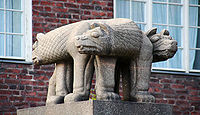
The name "Cerberus" is a Latinised version of the Greek Kerberos, which may be related to the Sanskrit word सर्वरा "sarvarā", used as an epithet of one of the dogs of Yama, from a Proto-Indo-European word *ḱerberos, meaning "spotted" [5] (This etymology suffers from the fact that it includes a reconstructed *b, which is extremely rare in Proto-Indo-European. Yet according to Pokorny it is well distributed, with additional apparent cognates in Slavic, British and Lithuanian).[6] The use of a dog is uncertain,[7] [8] although mythologists have speculated that the association was first made in the city of Trikarenos in Phliasia. [9]
Cerberus is said to be the sibling of the
Lernaean Hydra,
the
Nemean Lion, the Sphinx, the
Ladon, and the
Chimera.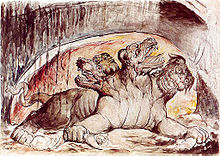
"Cerberus" is generally pronounced in English with a soft C as in cell, even though the ancient pronunciation, in both Greek and Latin was with a hard C as in cat.
Cerberus was the offspring of Echidna, a hybrid half-woman and half-serpent, and Typhon, a fire-breathing giant whom even the Olympian gods feared. Its brother is Orthrus, always depicted as a two-headed hellhound. [10] The common depiction of Cerberus in Greek mythology and art is as having three heads, a mane of live serpents (similar to Medusa's hair) and a snake's tail. In most works the three-heads each respectively see and represent the past, the present, and the future, while other sources suggest the heads represent birth, youth, and old age.[11] Each of Cerberus' heads is said to have an appetite only for live meat and thus allow the spirits of the dead to freely enter the underworld, but allow none to leave.[12] Cerberus was always employed as Hades' loyal watchdog, and guarded the gates that granted access and exit to the underworld (also called Hades).[13]
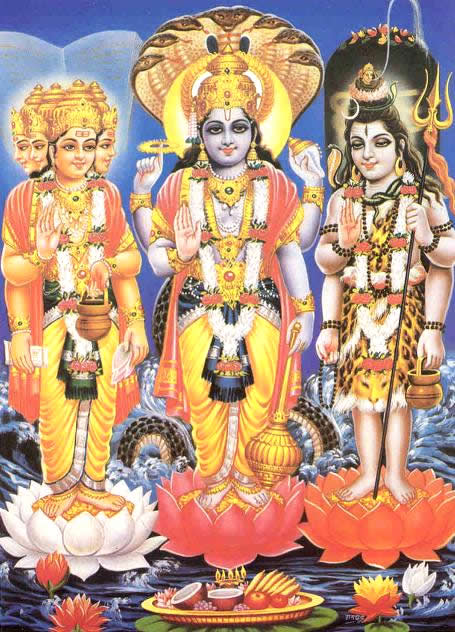
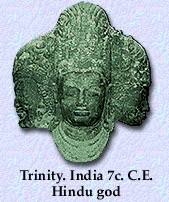
Idol worship and rituals are at the heart of Hinduism and have tremendous religious significance. All Hindu deities are themselves symbols of the abstract Absolute, and point to a particular aspect of the Brahman. The Hindu Trinity (Trimurti) is represented by three godheads: Brahma - the creator, Vishnu - the protector and Shiva - the destroyer.
The Hindu trinity is of Brahma, Vishnu and Shiva. They are respectively the creator, preserver and destroyer of the universe. They are also aligned as the transcendent Godhead, Shiva, the cosmic lord, Vishnu and the cosmic mind, Brahma. In this regard they are called Sat-Tat-Aum, the Being, the Thatness or immanence and the Word or holy spirit. This is much like the Christian trinity of God as the Father, Son and Holy Ghost. The trinity represents the Divine in its threefold nature and function. Each aspect of the trinity contains and includes the others.
Each God in the trinity has his consort. To Brahma is Saraswati, the Goddess of knowledge. For Vishnu is Lakshmi, the Goddess of love, beauty and delight. For Shiva is Kali (Parvati) , the Goddess of power, destruction and transformation. These are the three main forms of the Goddess, as Brahma, Vishnu and Shiva are the three main forms of the God. The three Goddesses are often worshipped in their own right as well as along with their spouses.
faculty.washington.edu/leiren/vikings2
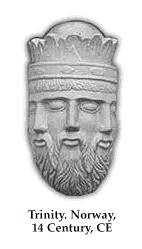

According to Adam of Bremen: "If plague and famine threatens, a libation is poured to the idol Thor; if war, to Odin; if marriages are to be celebrated, to Frey." Because Odin, the All-Father, was generally more feared than loved and subsequently kept at a distance, his son, Thor, assumed the position as favored deity. He was the protector and trusted friend. Some myths associated with Thor had him as almost human, with his foibles and gullibility. His hammer came to be used as an amulet, not only to signify the wearers allegiance to the old faith, but also as protection against the evils abounding. Odin and Thor were the most prominent members of the militaristic Æsir family. Frey, god of fertility and fecundity, led the Vanir family, the early opponents of the Æsir. However, a truce between them brought Frey to Valhalla and elevated his status to be one of the Norse trinity. With the conversion to Christianity, the Norse trinity, although driven underground by the Christian church, nevertheless, remained significantly conspicuous, albeit in changed form.
Scandinavian/Viking kings could easily be depicted as representations of the earlier pagan deities without the authorities of the Roman Church being any the wiser. In the same way that an anonymous woodcarver craftsman working on the Borgund Stave Church in western Norway could put a representation of the one-eyed Odin on the top of a column in the dark upper reaches of the sanctuary, so too could an artisan represent the pagan gods as medieval kings and/or saints. Consequently, with his axe, St. Olaf came to be associated with Thor and his hammer. In the tapestry, however, there seems to be a mixing of deities, as St. Olaf with his axe represents not Thor, but the one-eyed Odin who is placed next to a representation of a tree, perhaps the Yggdrasil from which he had hung. In addition, King Knud, killed at the alter of St. Albans Church in Roskilde, Denmark, is placed in the middle, holding a Thor-like hammer (the crucifix?), while King Erik ( the fertility diety, Frey) flanks him on his right holding an ear of corn. This arrangement, with Thor in the middle, is similar to Adam of Bremen's description of the idols in the great temple at Uppsala where Thor is said to be flanked by Odin and Frey.
List of triple deities...
Historical
polytheism
reference:
Wikipedia: Triple_deity#Triple_goddesses
- The Classical Greek Olympic triad of Zeus (king of the gods), Athena (goddess of war and intelect) and Apollo (god of the sun, culture and music)
- The Delian chief triad of Leto (mother), Artemis (daughter) and Apollo (son)[35][36] and second Delian triad of Athena, Zeus and Hera.
- In ancient Egypt there were many triads, the most famous among them that of Osiris (man), Isis (wife), and Horus (son), local triads like the Theban triad of Amun, Mut and Khonsu and the Memphite triad of Ptah, Sekhmet and Nefertem, the sungod Ra, whose form in the morning was Kheper, at noon Re-Horakhty and in the evening Atum, and many others.
- The Hellenistic Egypt triad of Isis, Alexandrian Serapis and Harpocrates (a Hellenized version of the previous), though in early Ptolomean religion Serapis, Isis and Apollo (who was though sometimes identified with Horus)
- The Roman Capitoline Triad of Jupiter (father), Juno (wife), and Minerva (daughter).
- The Roman pleibian triad of Ceres, Liber Pater and Libera (or its Greek counterpart with Demeter, Dionysos and Kore)
- The Olympian demiurgic triad in platonic philosophy made up of Zeus (considered the Zeus [king of the gods] of the Heavens), Poseidon (Zeus of the seas) and Pluto/Hades (Zeus of the underworld), all considered in the end to be a monad and the same Zeus, and the Titanic demiurgic triad of Helios (sun when in the sky), Apollo (sun seen in our world) and Dionysus (god of mysteries, "sun" of the underworld) (see Phaed in Dionysus and the Titans)
- The Julian triads of the early Roman
Principate:
- Venus Genetrix, Divus Iulius, and Clementia Caesaris
- Divus Iulius, Divi filius and Genius Augusti
- Eastern variants of the Julian triad, e.g. in Asia Minor: Dea Roma, Divus Iulius and Genius Augusti (or Divi filius)
- The Matres (Deae Matres/Dea Matrona) in Roman mythology
- The Fates, Moirae or Furies in Greek and Roman mythology: Clotho or Nona the Spinner, Lachesis or Decima the Weaver, and Atropos or Morta the Cutter of the Threads of Life. One's Lifeline was Spun by Clotho, Woven into the tapestry of Life by Lachesis, and the thread Cut by Atropos.
- The Hooded Spirits or Genii Cucullati in Gallo-Roman times
- The main supranational triad of the ancient Lusitanian mythology and religion and Portuguese neo-pagans made up of the couple Arentia and Arentius, Quangeius and Trebaruna, followed by a minor Gallaecian-Lusitanian triad of Bandua (under many natures), Nabia and Reve female nature: Reva
- The sisters Uksáhkká, Juksáhkká and Sáhráhkká in Sámi mythology.
- The triad of Al-Lat, Al-Uzza, and Manat in the time of Mohammed (surah 53:19-22)
- Lugus (Esus, Toutatis and Taranis) in Celtic mythology
- Odin, Vili and Ve in Germanic mythology
- The Norns in Germanic mythology
- The Triglav in Slavic mythology
- Perkūnas (god of heaven), Patrimpas (god of earth) and Pikuolis (god of death) in Prussian mythology
- The Zorya or Auroras in Slavic mythology
- The Charites or Graces in Greek mythology
- The One, the Thought (or Intellect) and the Soul in Neoplatonism
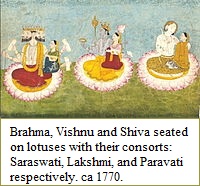
- The Saha Realm Trinity in Mahayana Buddhism (Shakyamuni, Avalokitesvara and Ksitigarbha)
- Brahma, Vishnu, and Shiva (Trimurti) in Hindu mythology
- Mitra, Indra, and Varuna in early vedic Hinduism
- Shakti, Lakshmi, and Saraswati (Tridevi) in Hindu mythology
- The Three Pure Ones in Taoism
- The Fu Lu Shou in Taoism
- Ayyavazhi Trinity
New religious movements
- The Triple Goddess in Wicca
- Nuit, Hadit and Ra Hoor Khuit in the Thelemic spiritual system
List of other triads
Triples in legendary beings:
- The Zoroastrian Magi (the "Three Wise Men" in Christianity)
- Aži Dahāka (Azhi Dahaka, Dahāg)
- Balam
- Balaur
- Bune (Bime)
- Cerberus
- Ettins
- Geryon
- The Gorgons and the Sisters Graeae in Greek Mythology
- Zmey Gorynych
Date of Origination: Friday, 28-April-2017... 02:40 AM
Date of initial posting: Sunday, 11-June-2017... 9:13 AM
Updated posting: Saturday, 31-March-2018... 1:09 PM